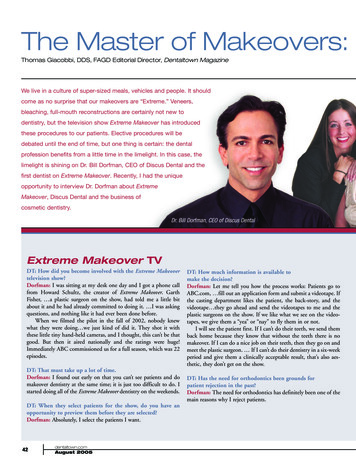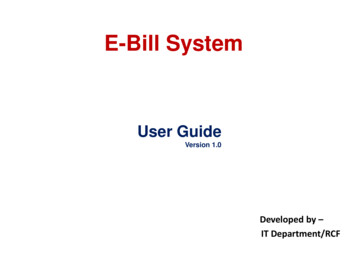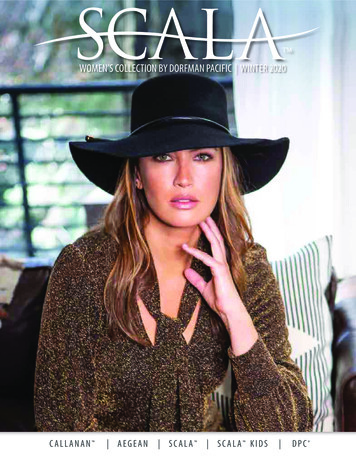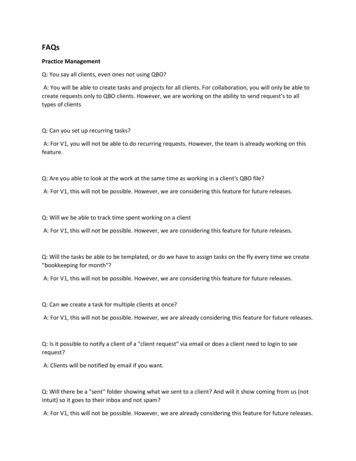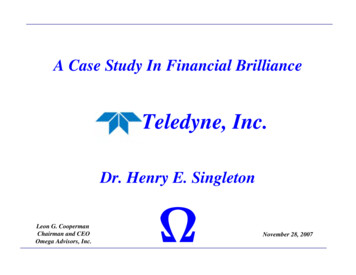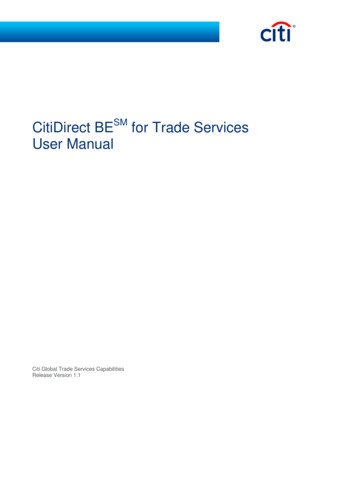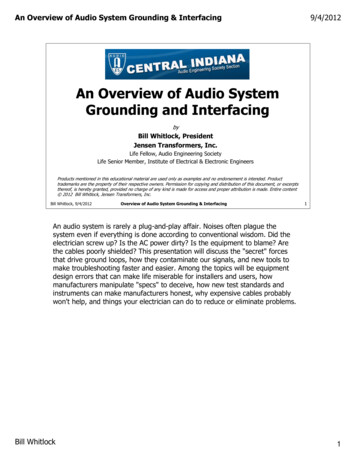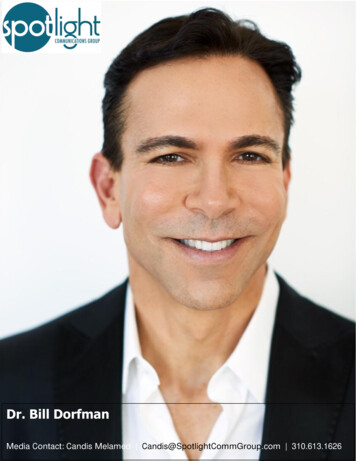
Transcription
Dr. Bill DorfmanMedia Contact: Candis Melamed Candis@SpotlightCommGroup.com 310.613.1626
Dr. Bill DorfmanA BiographyDr. Bill Dorfman is not just a famous cosmetic dentist, he is THE famous cosmetic dentist. Affectionately known as“America’s Dentist,” Dr. Bill is widely recognized world-wide as a leading dentist who is responsible for creatingsmiles for many of Hollywood's brightest stars. In fact, Dr. Dorfman has become a star in his own right as thefeatured dentist on the hit ABC series, "Extreme Makeover," where he performed amazing dental transformations onthe show's participants as well as a recurring guest co-host on the Emmy Winning daytime talk show, “TheDoctors.” In addition, Dr. Dorfman is a world-renowned lecturer & author of the best-selling cosmetic dentistry book,The Smile Guide & the New York Times bestseller Billion Dollar Smile.The innovative & accomplished doctor is also renowned in his field as an energy-brimming inventor & brilliantentrepreneur who has brought award-winning innovations to the world of dentistry.Dr. Bill Dorfman has been interviewed extensively for numerous television shows including ABC's Good MorningAmerica, The View, Oprah, CNN's Larry King Live, NBC's The Today Show, The Tonight Show with Jay Leno,Dr. Phil, The Rachael Ray Show, Steve Harvey Show, FABLife, The Doctors, Revenge Body with KhloéKardashian, The Tyra Banks Show, Ricki Lake Show, Home & Family, Entertainment Tonight, MTV's TheOsbournes & Newlyweds: Nick & Jessica, The Wayne Brady Show, The Sharon Osbourne Show, Living It Up!With Ali & Jack, EXTRA, Soap Talk, Access Hollywood & E! Entertainment Television. His expertise has beenfeatured nationally & internationally in digital & print magazines in publications such as Men’s Health, ELLE, RealSimple, Allure, Reader’s Digest, Martha Stewart Weddings, WWD, People Magazine, Life & Style Weekly, UsWeekly, OK!, Daily Mail Refinery29, Yahoo!, MSN, HuffPost, Bustle, Los Angeles Magazine, Los AngelesBusiness Journal, Marie Claire Arabia, Esquire Malaysia, Tatler UK, Enigma, Good Health UAE and Delta SkyMagazine, among many others.As a 1980 graduate from UCLA, Dr. Bill was honored with the prestigious "UCLA Outstanding Senior Award." Hethen received his dental degree in 1983 from the University of the Pacific in San Francisco, where he was one of theyoungest graduates ever to receive his doctorate degree. Upon graduation, he completed a two-year residency at adental hospital in Lausanne, Switzerland. In 1985, Dr. Dorfman returned to the United States & established hisprivate practice in aesthetic & general dentistry.Dr. Bill has often been referred to as “the Michael Jordan of Dentistry” – In 1989, at the age of 30, Dr. Bill formed thehugely successful company, Discus Dental, Inc., the world's leading manufacturer & distributor of tooth-whitening,oral hygiene & aesthetic dental products. Here he helped develop such ground-breaking professional take-hometeeth whitening products as Nite White, Day White, & Breath Rx. His company also launched Zoom! & Brite Smileboth revolutionary in-office whitening system which uses a safe, effective & gentle light-activated gel to whiten teethby 8 to 10 shades in just over an hour. More recently, after 20 years of becoming a leader in teeth-whiteningproducts, Dr. Bill sold Discus to widely recognized Philips Electronics – makers of Sonicare.Dr. Bill is a member of the American Dental Association & he is one of only 100 Fellows in the American Academy ofCosmetic Dentistry, only two of which are in Los Angeles. In addition, he was the founder & program coordinator ofP.A.C.-live, a continuing education program to teach practicing dentists state-of-the-art cosmetic dental skills on livepatients, at the University of the Pacific Dental School. He has been honored by being recognized as the "BestAesthetic Dentist in Los Angeles" by Los Angeles Magazine and, by the young age of 42, was awarded not one, but
two lifetime achievement awards from the largest academies in dentistry & has since then been awarded a total of 20lifetime achievement awards.Throughout his accomplished career, Dr. Dorfman has been committed both to educating the public about the worldof dentistry & to giving back to the community. In association with the Crown Council of Dentistry, Dr. Bill offeredDiscus Dental's assistance in donating all of the whitening materials for its annual four-month charity campaign,Smiles for Life. Each year, the Crown Council dentists donated their time & services to offer consumers toothwhitening at a lower rate. Then, 100% of the money earned was donated to country singer Garth Brooks'"Teammates for Kids Foundation," which in turn gives to children's charities across the U.S. Thus far, they haveraised & donated more than 40 million to more than 115 children's charities, including St. Jude's Children'sResearch Hospital & the Children's Dental Center.In addition, Dr. Bill is dedicated to aiding the many graduates of Los Angeles' Battered Women's Shelter, a downtownrefuge that helps survivors of harrowing physical violence heal & rejoin the world. Since 1997, Dr. Bill has helpedrestore the smiles of abused wives, rape victims, former prostitutes, drug addicts & unfortunate women at no chargein order to assist them on their path to confidence. He has not only traveled to South Africa to help raise money &awareness for Tomorrow Trust – a non profit organization that helps orphan children affected by HIV & AIDS, but healso co-founded the non-profit LEAP Foundation at UCLA (www.leapfoundation.com).LEAP is a summer motivational leadership program for students 15-25 designed to help obtain valuable life skills thatthey wouldn’t otherwise learn in a traditional classroom setting. Skills such as business etiquette, time management,making a first impression are all taught through seminars, celebrity and motivational speakers & mentors. Now in its12th year, LEAP has inspired thousands of young students. It is noteworthy that over 60% of the students attendingcome from impoverished families and Dr. Bill has not only raised millions of dollars so students could attend but hehas personally donated more than 1.5 million to LEAP scholarships.His innovation, humanitarian & philanthropic endeavors have earned him 20 Lifetime achievement awards. Dr. Billwas also included in the Guinness Book of World Records twice - for ‘Most Money Raised for a Charity ThroughHead Shaving by an Individual,’ after raising more than 120,000 for LEAP by shaving his head live on the EmmyWinning daytime talk show, “The Doctors;” and for ‘Most Valuable Grill,” after creating Katy Perry’s 1 million grill forher Dark Horse music video. More recently, he was inducted into the Royal Order of Constantine Knighthood, forhis contribution to the advancement of dentistry and his philanthropic endeavors – making him the first dentist toreceive the title and honor of Knight.A multi-faceted individual, Dr. Bill is not only a leader in the world of dentistry and active in philanthropy, but he isalso active in the world of fitness & beauty as a repeat judge for the Miss USA beauty pageant. His personal fitnessregime includes a strict, healthy diet and outdoor activities that include water & snow skiing, biking, climbing,swimming & scuba diving with fitness features in GQ UK, Tatler, Health Aging, Image & Style, Exercise for MenOnly, WaterSki Magazine, Jewish Journal Health Guide and Supermodels Unlimited, just to name a few. WhenDr. Bill Dorfman is away from his busy dental office, he enjoys traveling and spending time with his three daughters.Additional information may be found at Dr. Bill Dorfman's official website: www.billdorfmandds.com.###
New York Times Bestselling AuthorFitness EnthusiastInternational LecturerPhilanthropistCelebrity Cosmetic DentistTwo Guinness Book World RecordsEntrepreneur
How to Work out when you’re over 60By: Dr. Bill Dorfman May 2, 2020I will admit it is much easier to get variety when you can go to a gym, but in our world today weneed to creatively come up with an at-home fitness plan.Typically, I alternate daily between two workout routines. The goal is to maintain strength,flexibility, endurance and maximize the core. Especially as we age, one of the most importantways to stay fit and prevent injuries is to focus on using lower weights and doing morerepetitions. Heavy weights tend to damage our joints, ligaments and muscles.Staying active as one gets older is a great way to promote a healthier, longer life and – if doneproperly – prevent injuries. However, before beginning a workout plan, it is important toconsult a medical professional with a knowledge of your personal medical history. Most expertsrecommend at least 30-45 minutes of moderate physical activity be performed daily.At the beginning of each session, it is imperative to warm-up with at least five to ten minutesof stretching. Typically, I like to do basic toe touching, seated pike bending, groinand calf stretches and wrist and shoulder stretches. If you are not sure how to do these, eithergo online or, when safe, take a class or hire a trainer.
If you are trying to build your physique or just stay more active, here are some tips andexercises. For simplicity, I have labeled my workouts plan A and plan B. As stated earlier, Ialternate between the two daily.Workout A: abs and aerobic exerciseStart by doing some of the stretches I suggested above for five to ten minutes.Then, for the ab exercises, I normally do sets of 50-100 of the following exercises without anyrests. However, if that is too much to start with, lower the reps to 20 and take short breaksbetween exercises. Using a Bosu ball, you can do crunches (lay on your back and touch oppositefoot to hand) in sets of 50 or oblique twists – sometimes called “penguins” – again in sets of50.Alternatively, using an AB roller (wheel with a handle), start upright from your knees andextend forward till you are flat on the floor on your stomach, then pull back to an uprightposition, still on your knees.You can also try sit-ups: start at sets of at least 20 and try to work up to sets of 100. If it helps,lock your toes under your bed frame. Also worth trying are bicycle crunches. Laying on your
back, raise your bent knees to 90 degrees with your feet extended. Then touch your elbow tothe opposite knee. Try doing sets of 50.Also great are leg lifts. Lying on your back, you can hold on to your bed frame or a couch forstability and do leg lifts from the floor to the bed or couch and then back to touch theground. Try doing sets of 50.After you go through these exercises, repeat until you hit 30 minutes. After your half-hour absworkout, move to doing 15-20 minutes of aerobic exercise. This could be jogging, walking,swimming, indoor or outdoor biking or a rowing machine.Workout B: bodyweight and dumbbellsComplete two sets of eight to ten repetitions for each of the following exercises:1. Pull-ups: Using a bar, alternate between overhand and underhand hanging pull-ups. Two setsof eight to ten reps each. If possible, repeat until you tire.2. Dumbbell rows: Two sets of eight to ten reps with as much weight as you can comfortablyuse to complete both sets. Start with the right knee and hand on a bench (bedside bench or asturdy coffee table with a pillow or towel for comfort) and the left foot on the ground. Grab theweight with the left hand and lift the weight from the floor until it touches your chest. Aftereight to ten reps, rest 30 seconds before switching sides.3. Dumbbell hammer lifts: Two sets of eight to ten reps with as much weight as you cancomfortably use to complete both sets. Starting with both dumbbells at your side, alternatelifting from the start position and bend your elbows until the weight approaches your shoulder,without twisting the position.4. Dumbbell curls: Two sets of eight to ten reps with as much weight as you can comfortablyuse to complete both sets. Starting with weights at your side, either lift both weights at thesame time or alternate, but lift with your wrists facing straight up.5. Push-ups (hands under shoulders, feet together): Two to three sets of 20 reps each. Increaseyour reps as you gain strength.
6. Diamond push-ups (hands right under chest, legs two to three feet apart): Two to three setsof 20 reps each. Increase reps as you gain strength.7. Ten minutes of ab exercises as listed above.Doing a combination of both plan A and B throughout the week with give you a comprehensivefull-body article/workout-for-men-over-60
The ten changes every man should make after the age of 60The healthy eating advice all men aged over 60 should hear. Trust usBy Dr. Bill Dorfman June 2, 20191. What is the best way for men over 60 to exercise?First, it depends on how active you are and how active you want to be. If you are just startingout, you may want to get a medical consult first. The American College Of Sports Medicinerecommends 30 minutes of moderate physical activity “most” days of the week. With school,work and kids, I could only manage to exercise for about one hour three to four days a week formost of my adult life. However, in 2010 I cut my work hours back to only 20 hours a week ofdentistry to make time for charity work and entrepreneurial endeavors. As a result, I am nowable to exercise daily for 60 minutes and have been doing this for the last ten years. I canhonestly say I am in better shape today than I was in my twenties because I have the time,knowledge and diet to maximise my results.My personal mantra is: “You can rest when you're dead.”
At 60 years old the main focus needs to be strength training to prevent bone and muscle loss. Inaddition, it is paramount to incorporate flexibility and cardiovascular activity into the mix. If youcan shoot for two to three days at the gym and three to four days of cardiovascular workoutssuch as aerobics, swimming, walking, jogging, biking or rowing you will be set. For cardio andgym days I always start with five to ten minutes of stretching. This helps to avoid injury andstrains.I have noted that generally it is not convenient for most of us to work out with a trainer atevery gym session, however, I am a big supporter of working with a trainer to make acomprehensive routine and then follow up with them every two to three months to revise theplan as your goals are reached. Make sure you incorporate the following major muscle groups:abdomen, arms, back, chest, legs and shoulders.2. What exercise do you think we should avoid?As we age our joints cannot tolerate the stress of excessive weight. Therefore, the healthiestway to exercise in order to avoid injury is to use lower weights with more repetitions. For eachexercise I suggest doing two sets of eight to ten repetitions with a comfortable amount ofweight. This will produce a leaner more “ripped” aesthetic result as well. Also, machines arepreferred over free weights. The assisted movement of the machine compensates by stabilizingthe weight and helps to prevent injury.
3. When is the best time to work out?When you can! For years I went before work. Now, I go at the end of my work day. I find thatmy muscles are not as stiff later in the day and I get a better work out.4. What foods should we eat more of as we get older?In general, we should always try to eat more of the “superfoods” at every stage of life. Theseinclude: wild salmon, blueberries, broccoli, tomatoes, soy, flaxseed, oats, strawberries,cantaloupe, garlic, beans, green tea. Personally, I love to start each day with a fruit, protein,flaxseed and oats smoothie. I have been doing this for 30 years!5. Which foods should we avoid?I don't eat junk food, highly processed food, fried or fatty foods. I also avoid all alcohol. It is apersonal choice, not because I ever had a problem. Also, a recent study published in the Lancetrejects the notion that any drinking can be healthy.6. Any other diet advice you can share?Eat smart and remember that what you eat today will make you what you are tomorrow. Try tofocus on three healthy meals a day and little-to-moderate snacking between meals.7. What do you say to people who say they are too busy to exercise?If you want to live a long and healthy life, you need to not only make exercise a priority, butpart of your life. I was once asked how I got in such great shape. My reply was: “I did not get ingreat shape. I was an athlete as a kid and have always kept exercising my whole -diet-for-over-60-men
Staying in Shape for LifeBy Dr. Bill Dorfman November 2018After dedicating 55 years of my life to exercising regularly and eating properly, most people sayI look 20 years younger than my actual age. I turned 60 this past September and am in bettershape now than I was when I was in my 20s!It’s no secret that the current craze is fitness. Everyone wants to be fit with solid abs andbiceps. This is easier at 20 and 30. But it becomes more of a rarity at 40 and even more so at 50.At 60, it’s almost unheard of!Even though I was always active in sports as a kid, I decided to work out more regularly while indental school. This may seem ironic since the most common excuse for not exercising is “I don’thave the time.” But dentistry is psychically demanding. So, unless I exercised daily, my back,neck, and shoulders were constantly in pain. The more I worked out, the better I felt. So, I justkept it up for the better part of the last five decades.
As I got older and my schedule grew more and morehectic, it became increasingly difficult to find time toexercise. Here’s a snapshot of my life: I got married and had three kids. I was working 60-hour weeks and transforming thesmiles of many of Hollywood’s brightest stars. I wrote what would become a New York Times bestseller, titled Billion Dollar Smile: A Complete Guide toYour Extreme Smile Makeover. I founded Discus Dental, the makers of the world’sleading tooth-whitening products NiteWhite,BriteSmile, and Zoom. I founded my nonprofit LEAP Foundation to help high school and college students succeed inlife. I appeared on ABC’s Extreme Makeover and CBS’ The Doctors, the latter of which I still appearon today. I helped raise 42 million for children’s charities. I earned 18 lifetime achievement awards.Instead of making excuses, I make going to the gym a daily priority—whether I’m traveling ornot. For the past 40 years, I’ve averaged a 60- to 70-hour work week, as many Americans do,and still made time to exercise daily.When my kids were growing up, I got up at 5:30 a.m. and exercised before work so I could behome with them every night. Now that they’re older, it’s a bit easier to make time. So, I oftengo after work. No matter where I am or what I’m doing, my gym time is one thing that nevergets bumped from my schedule.I usually alternate my workouts between lifting weights one day and cardio and abs the nextday. Even though a lot of people have a rest day, I tend to work out every day for at least anhour because it helps me feel more alert and productive at work. In addition to feelingphysically fit, I also lead a physically “pain-free” life.Choosing a lifetime of fitness has prolonged my career and has enabled me to liveadventurously. I swim, run, hike, scuba dive with sharks, and water and snow ski on a regular
basis. I don’t need a personal trainer every day. But every four to six months, I use one to mixup my routine so I don’t get bored.When beginning a fitness journey, there are three key things to consider:1. Diet.2. Exercise.3. Genetics.We control two of these three components. But you should hold yourself accountable and takeresponsibility for all three of these factors. For diet and exercise, it may be obvious what youshould do. And for genetics, there are a plethora of tests that can help you in overcomingobstacles. Master these three key things and you’ll be well on your way to a successful, and fit,lifestyle.I consider myself fortunate to have everything that Ihave. But I also acknowledge that none of it would havecome without the diligence and dedication that I’veexercised over the last 55 years.To my peers who are looking to maintain a healthylifestyle while aging, I say make diet and exercise apriority, eat well, and do something active daily. Getannual checkups from your doctor and, when it makessense, do genetic testing to prepare yourself for a longand healthy life!It’s not just about getting fit. It’s also about staying fit.It’s not easy, but it is necessary. And it does pay off!Dr. Bill is a celebrity dentist from the ABC hit show Extreme Makeover and the CBS Emmywinning daytime talk show The Doctors. He’s been featured nationally and internationally onnumerous talk shows and national magazines. See more on his Instagram taying-in-shape-for-life/
Considering Botox to Help With TMJ? Read This FirstKirbie Johnson August 28, 2019I like to grind. Work-wise, dance-wise—let’s grind it out. But there’s an area I don’t appreciate grinding, and that’s my mouth. I remember whenI first realized I was mercilessly grinding my teeth at night: I was on a shoot, getting ready to interview celebrity cosmetic dentist Bill Dorfmanabout teeth whitening. Before filming, he inspected my teeth to make sure everything was good to go.“Your teeth are beautiful, but do you experience jaw pain?”Thinking about it, yes, I did. My face and head felt sore all the time. I had more headaches in a month than I recalled having.ever (not relatedto politics at that point. Those were the days.) How did he know that? Turns out, my masseter muscle—more on this later—and teeth were adead giveaway, specifically, my top incisors (the middle two teeth) and my cuspids (the canine teeth) of both my upper and lower jaw.My cuspids had been sanded down from pointy to flat and straight-edged, and my front two teeth were uneven in length. These were the visualred flags that I had been getting my grind on. The masseter muscle is the muscle that helps you chew—it’s connected to your lower jaw andcheekbone. Because of my grinding, it’s like that muscle had been pumping iron: the constant chewing motion caused the muscle to becomeenlarged, altering the shape of my face. Dr. Dorfman cosmetically sanded my front two teeth so they were the same length and suggested I geta mouthguard to prevent future damage, but also suggested I look into the cause of this: r-tmj-review/
7 Daily Habits That Seem Healthy—but Are They Really?Karen Asp August 26, 2019When it comes to getting healthier from the inside out, there’s no end to the number ofhealthy habits you can adopt. But just start thinking about them all and your head will start tospin. The truth is, not all of these habits are as healthy as they’re cracked up to be. But how doyou know?We turned to the experts to get the scoop behind seven habits that sound healthy—but thetruth behind them may be more complicated. Read on to see which ones get the green light,and which healthy habits you can reconsider.2. Flossing dailyThe verdict: Do it.What the expert says: “Brushing cleans only three of the five exposed tooth surfaces, so toclean the other two, you must floss,” says Bill Dorfman, DDS, a Los Angeles-based cosmeticdentist from the ABC's Extreme Makeover and author of Billion Dollar Smile. If not, you’ll getcavities between those teeth; left untreated, they can lead to numerous issues. Worse?“Residual plaque that’s left can lead to chronic mouth infections, which have been linked toheart disease,” Dr. Dorfman says. Aim to floss at least once a day before you brush, using an upand down motion, and be sure you know how to floss tative-health/healthy-habits-myths
Is it Safe to Go to the Dentist During COVID-19? Here's What Experts SayBy: Leah Groth May 14, 2020The first question: Is your state allowing elective dental procedures? The second: Howcomfortable are you with going to the dentist right now?Like so many other industries across the US (and really, the world), the dental industry has beendramatically impacted by the COVID-19 pandemic. According to the American DentalAssociation (ADA), 90% of all dental offices opted to close except for urgent or emergencyprocedures, per guidelines directly from the Centers for Disease Control and Prevention.The main reason for this, of course, is due to the nature of how novel coronavirus is spread—mainly via respiratory droplets—and how likely it is for the virus to spread in the dental setting.And while personal protective equipment (PPE) can be an effective barrier, due to the shortage,there isn’t enough gear available to go around—even for emergency healthcare workers.(Dentists in France have even taken to protesting these PPE shortages by getting naked.)But now, as social distancing guidelines are starting to relax across the country, many states—39 as of May 13, per the ADA's interactive map—are allowing dental offices to reopen forelective procedures, such as teeth cleaning. But should you make an appointment ASAP, or is itbetter to wait it out a little bit longer? And if you do need an emergency dental procedure,what types of safety precautions are dental offices taking to ensure not only your health, butthe health of their employees? Here's everything you know about going to the dentist rightnow, during a pandemic.How safe is it to go to the dentist right now, in general?So let's say your state is allowing dental offices to be open for elective procedures. There are afew things you, as a patient, should know about your risk of contracting COVID-19 in a dentalsetting—specifically regarding how exposed you are as a dental patient.
Because COVID-19 spreads primarily through respiratory droplets that often make their wayinto your mouth, nose, or even eyes, you may be putting yourself in danger while sitting in thedentist chair (remember: dental hygienists and dentists are all up in your mouth duringcleanings and procedures—and you wearing a mask is basically impossible). Viral transmissioncan happen if someone isn't showing symptoms yet, so even if a dental office is making staffwho are showing symptoms stay home, that won't be helpful if a staffer is asymptomatic. Thatsaid, "as long as the dentist and assistants wear masks and get tested," a dental procedure canbe perfectly safe, Joseph Vinetz, MD, a Yale Medicine infectious disease doctor and professor atYale School of Medicine, tells Health.What many fail to consider in these situations is the health and safety of the dentists and dentalhygienists, who are actually much more at risk for contracting COVID-19 than patients, BillDorfman, DDS, a Los Angeles-based celebrity cosmetic dentist, tells Health. It comes down toproper PPE again—while dental staff wear face masks and protective eyewear, patients cannot.(Overall, face coverings have more protective benefits in keeping germs away from healthyindividuals when an infected person is wearing a mask, not necessarily vice-versa.)Also, as you probably know, those dental procedures are often pretty messy—teeth cleaning,water flossing, and other similar procedures that use high-speed dental instruments canpotentially spray viral particles in greater amounts and longer distances throughout a dentaloffice and onto the dentists themselves, only adding to the possibility of infection. Ultimately,"the chances of a patient being infected by a dentist is much, much lower than a patientinfecting a dentist," says Dr. Dorfman. "The biggest exposure is going into somebody's mouth.It's the dentist and dental office that is at a bigger risk."What are dental offices doing to protect patients and staff from COVID-19?Even before the pandemic, dental offices were required to maintain pretty strict hygienepractices. Charles Sutera, DMD, FAGD, cosmetic dentist and founder of Aesthetic SmileReconstruction, tells Health. He explains that all dental practices already follow OSHAstandards for cleaning and sanitizing everything with EPA-approved disinfectants speciallydesigned for use in a healthcare setting to kill viruses, bacteria, and other pathogens.Additionally, it has long been standard protocol for an entire dental care team to wearprotective gear, including gloves, surgical masks, and goggles for eye protection to minimize therisk of transmitting germs from one patient to another. “These standards are in practice everyday, regardless of whether there’s a known outbreak of an infectious disease,” he says.Now, due to COVID-19, there are additional safety precautions in place, many of themrecommended by the Centers for Disease Control and Prevention and the American DentalAssociation. “When open during the COVID-19 pandemic, we enforce social distancing betweenall individuals in the office—patients and staff—when not wearing personal protectiveequipment, and routinely disinfect common surfaces in lobbies or waiting rooms, includingdoorknobs, countertops, and pens,” says Dr. Sutera.When more people eventually start coming in for dental procedures, Dr. Sutera says that manyoffices—including his own—will start staggering appointments with more time allotted for eachpatient in order to reduce the number of people in the office at any given time. “Chairs will be
placed six feet apart in the waiting room," he says, and "depending on the facility design, youmay be asked to wait in your car, or you may be taken immediately back to a private roomupon arrival." And if you want reading material, you may have to bring your own. "The usualmagazines, toys, etc in waiting rooms will be removed," says Dr. Sutera. "In their place you willfind tissues, hand sanitizer, and extra trashcans."Staff will also take many extra precautions, including having illness screenings and dailyte
then received his dental degree in 1983 from the University of the Pacific in San Francisco, where he was one of the youngest graduates ever to receive his doctorate degree. Upon graduation, he completed a two-year residency at a dental hospital in Lausanne, Switzerland. In 1985, Dr. Dorfman returned to the United States & established his
